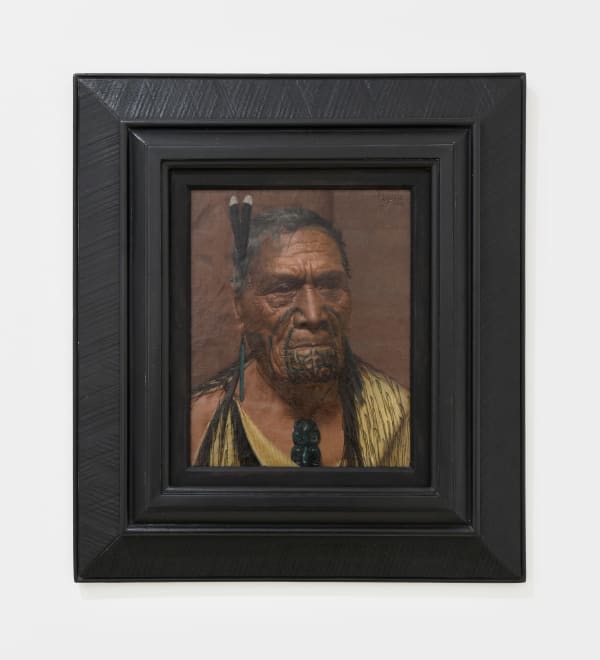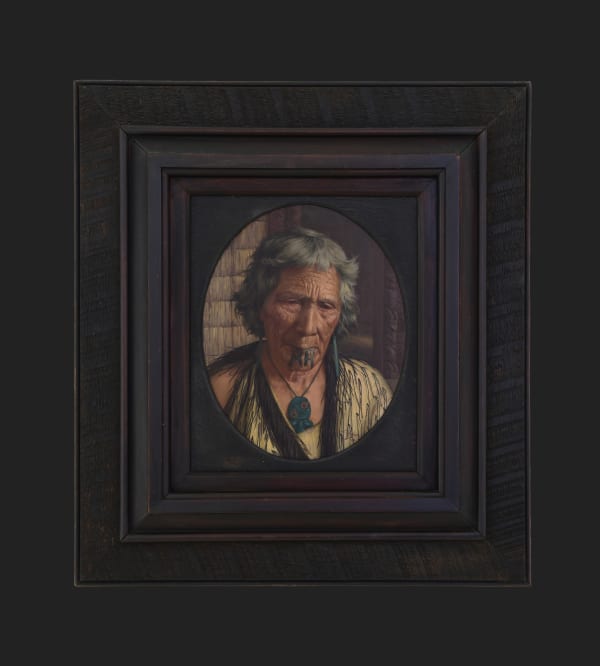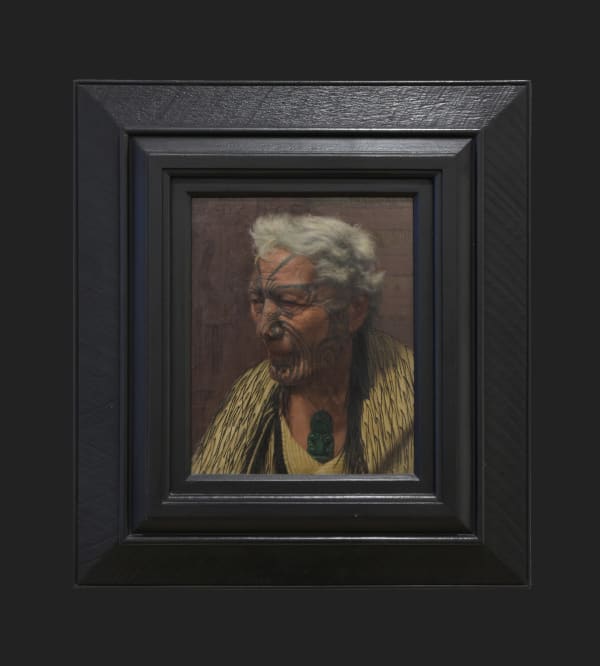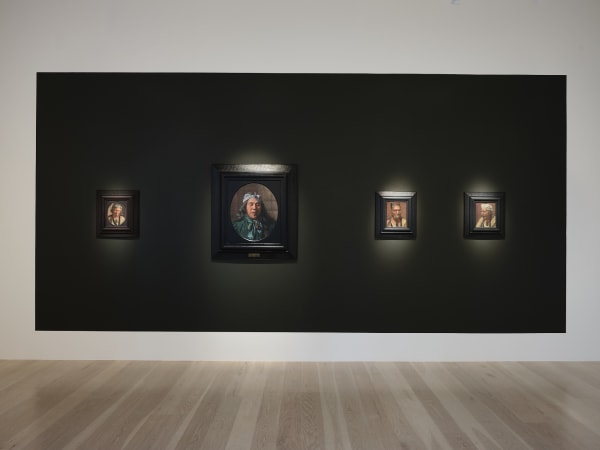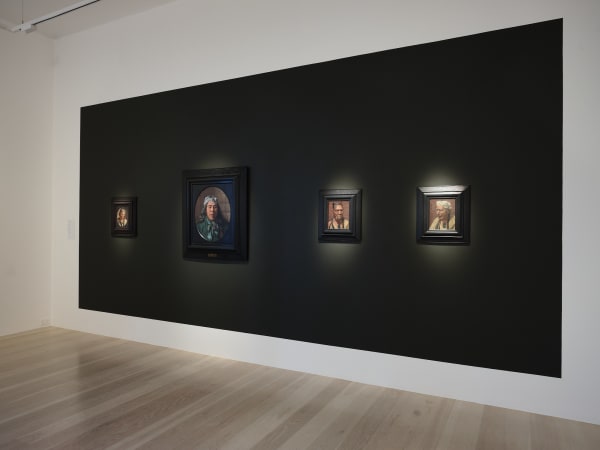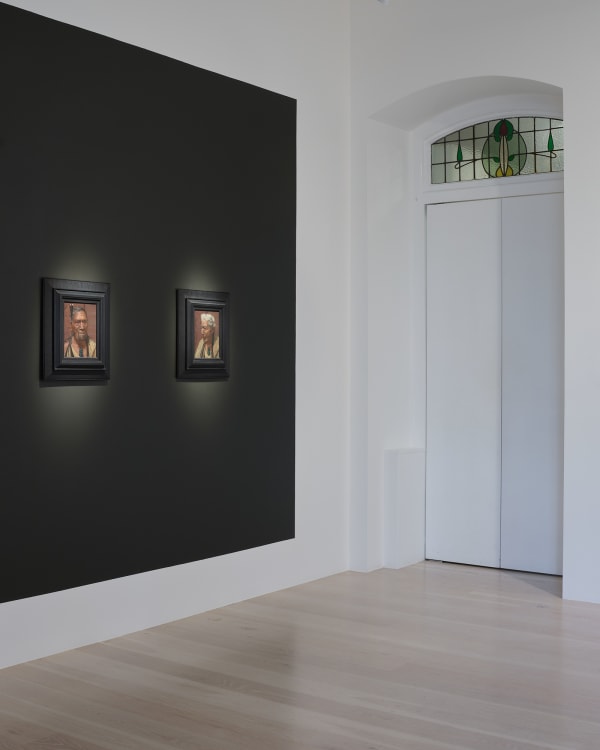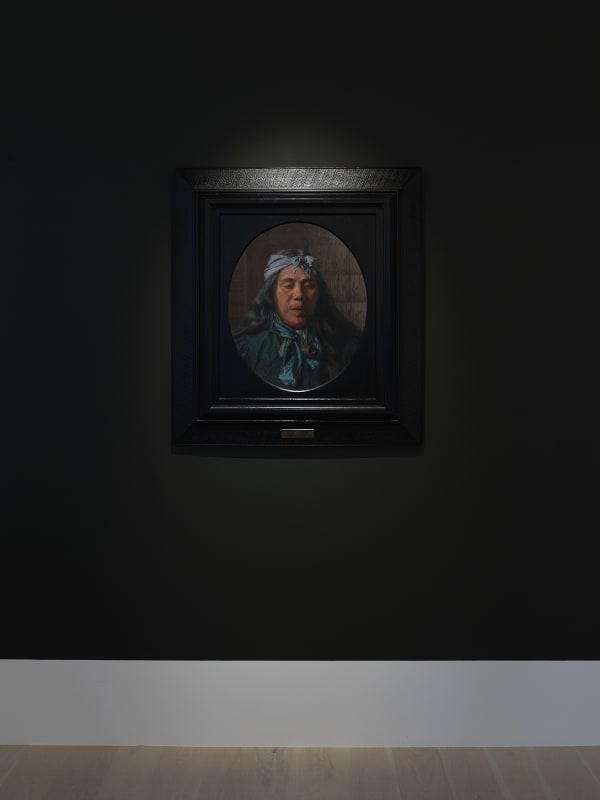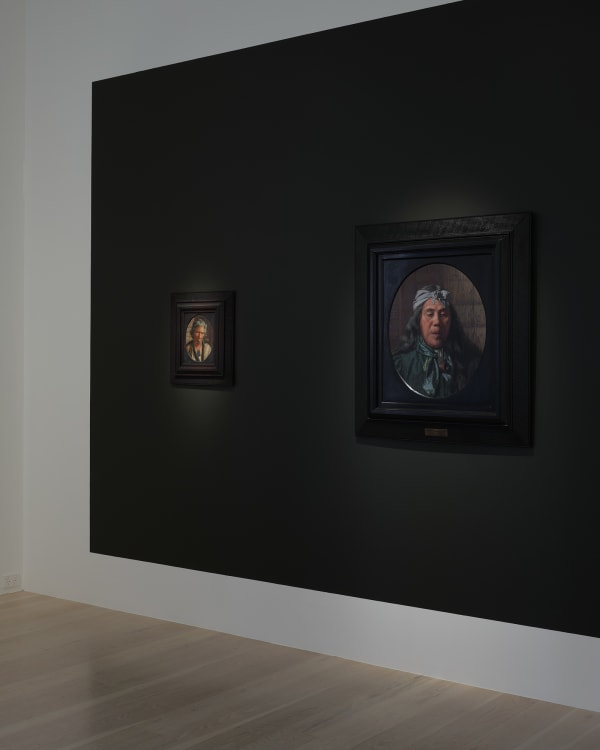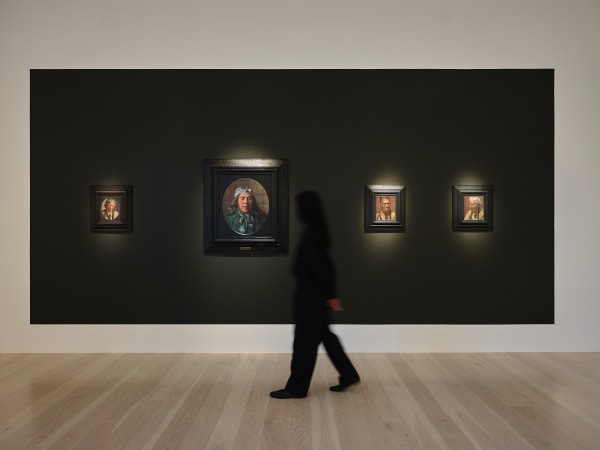Four Paintings, Four Sitters: Charles F. Goldie
The paintings included in Goldie: Four Paintings, Four Sitters provide a compelling view of the technical virtuosity and distinctive subject matter that made Goldie famous. These works range in date from 1910 to 1918, which situates them in the most productive and esteemed period of the artist’s production.
"Goldie is New Zealand's 'Old Master'. Museums and individual owners will continue to treasure his works, while his stature as the country's paramount academic painter of the early twentieth century will undoubtedly be re-evaluated by successive generations."[1] - Roger Blackley
Charles Frederick Goldie is quite possibly New Zealand's most famous artist. His work has enjoyed a wide audience and has been the subject of countless column inches since his heyday in the early 1900s. Now, more than 75 years after his death, interest in his paintings remains buoyant. Goldie's richly detailed portraits of Māori sitters are highly distinctive. His oeuvre is possibly the most widely recognised in the country's history, rivalled only by that of Colin McCahon. To some, his paintings showcase the pinnacle of artistic achievement, demonstrating an unsurpassed mastery of oil paint and level of technical flair. To others, they are a relic of a bygone era, representing an unpalatable worldview deeply entrenched in colonial narratives and a narrow artistic vision. Such divided opinions have followed Goldie's work since at least the 1950s.[2] Regardless of these diverse and at times divisive perspectives, Goldie is a highly significant figure in New Zealand's art history.
The paintings included in Goldie: Four Paintings, Four Sitters provide a compelling view of the technical virtuosity and distinctive subject matter that made Goldie famous. These works range in date from 1910 to 1918, which situates them in the most productive and esteemed period of the artist's production. Born in 1870, Goldie studied under artist J.L. Steele after completing his schooling at Auckland Grammar School. He trained in Paris at the Academie Julian in the 1890s, where he proved to be an adept pupil, earning the academy's bronze and gold medals in 1896 and 1897 respectively.[3] This period in Paris also allowed him access to the city's great museums, which he often visited to scrutinise great works of painting.
He returned to New Zealand in 1898 and began sharing a studio with Steele in Auckland. It was there that the two artists completed the collaborative painting The Arrival of the Maoris in New Zealand [sic]. This painting, now held in the permanent collection of Auckland Art Gallery Toi o Tāmaki, was based on the famous Raft of the Medusa painted by Théodore Géricault. Subsequently, Goldie established his own studio and began creating his highly distinctive portraits of Māori sitters.
Goldie painted Nikorima and Nicotina in 1910. According to the late Roger Blackley, a noted authority on Goldie, the work depicts Katarina Nikorima, who was married to a leading chief of Ngāti Maru and lived near Thames. According to Blackley, "Her contemporary fame was based largely on the superb contralto voice she exhibited at charity concerts, which drew vociferous demands for encores."[4] The painting presents the model wearing scarfs around her neck and head with a tobacco pipe hanging from her mouth. Smoking was uncommon for women at the time, though Blackley states it was more widespread among Māori. "Release from the constraints of European fashion and decorum was a pleasure of the Māori world, where women were free to smoke pipes and wear comfortable loose clothing."[5] Intriguingly, Blackley notes that Goldie had also painted Nikorima nine years earlier wearing the very same scarf.
This work, the largest presented here, is a prime example of the artist's extraordinary technical finesse. Painting conservator David J. Wise has described some aspects of the artist's processes, "Once the general features were established and the forms modelled to his satisfaction, Goldie started work on the finishing layers. This included the addition of details using fine, pointed brushes - for example in the areas of tassels and their shadows on cloaks - and the final highlights and shadows to the facial wrinkles. It was also at this point that Goldie painted the models' hair, building it up with an interwoven mat of increasingly finer brushstrokes […]. The finishing touches also saw the modification of tones and the strengthening of shadows by the use of scumbles (light colour oil paints, diluted very thinly with turpentine) and glazes (trans-parent pigments mixed with resin varnishes)."[6] Such an organised approach to layering was vital to achieving the end result.
Memories, Rakapa (an Arawa Chieftainess) is also from 1910. The work depicts Rakapa Te Tira, a Te Arawa Rangatira. Goldie painted this sitter several times between 1910 and 1918. According to Christchurch Art Gallery Te Puna o Waiwhetu, "Rakapa Te Tira (also known as Rakapa Manawa/Ngatatau/Rapana/Mitai) was a rangatira (chief) of Te Arawa who lived at Te Takinga marae at Mourea, on the eastern shores of Lake Rotorua"[7] A fine example of Goldie's highly distinctive portraiture, this painting depicts its subject with a downcast, and perhaps dejected, gaze. This 'classic Goldie' demeanour is a source of continuing controversy around the artist and his work. A discourse prevalent among Pākehā of the early 1900s concerned the decline and uncertain future of Māori.[8] This colonial narrative is unpalatable to contemporary audiences and remains a sticking point in discussion of the artist. Blackley contended, however, that Māori audiences have often expressed admiration for Goldie's work, including at the time of his production and in more recent years. He stated, "Māori enthusiasm for Goldie's works is intrinsically linked to their nature as portraits. As depictions of named individuals, the paintings command respect and evoke pride, especially among descendants and relatives of those depicted."[9]
Life's Long Day Closes dates from 1917. According to Alister Taylor and Jan Glen, the authors of C.F. Goldie: His Life & Painting the sitter for this painting is Atama Paparangi, chief of the Taumai hapu of the Rarawa tribe. "He was a famous warrior and fought at Kororarcka with Tamati Waaka Nene's men against Hone Heke. Atama also fought at Okaihau. In later years he became patriarch of his tribe. He lived at Mitimiti, on the coast between Hokianga and Whangape."[10] Taylor and Glen suggest the artist and sitter met in 1901. "Occasionally Atama travelled down to Auckland, and appeared around the streets dressed in a frock coat and top hat. He travelled to Auckland in 1901 to attend the official functions during the Royal visit by the Duke and Duchess of Cornwall and York. Goldie probably made his acquaintance at that time, although his first painting of Atama dates from 1912. […] Atama had a striking tattoo, executed at Pupuwai by the famous tattooist Huitara. The old chief stood over six feet high and was a hundred years old when he died in 1917." Evidently, Paparangi was among Goldie's favourite models, appearing in numerous works over several decades including some painted from photographs many years after Paparangi had died.
Another frequent sitter for Goldie was Hōri Pōkai (Ngāti Maru, Ngāti Paoa) who is the subject of The Strategist from 1918. This painting features a muted and earthy palette. The Rangatira is depicted wearing huia feathers in his hair, a sign of stature and mana. He is also shown with a pounamu pendant hanging from his ear and a heitiki around his neck, further signals of status. The Strategist is technically masterful, demonstrating the highly refined craft that Goldie had developed by this stage of his career. Wise discusses this in terms of the artist's academic training at the Academie Julian, stating, "The search for naturalism and the transient effects of light as pursued by the Barbizon artists and the Impressionists through 'plein air' sketching was the antithesis of the control exercised by the academic artist. Light in the studio was filtered, diffused and organised to delineate the forms. Harsh contrasts between shadow and highlight were avoided through the use of carefully modulated tones and harmonious colours."[11] This highly specific approach to painting is fully evident in The Strategist.
Goldie died in 1947, a shadow of his former self. Taylor and Glen noted that his experience of ill health and decline in later life could possibly be attributed to lead poisoning. "When preparing his canvases, Goldie used flake white to give a smooth surface. Flake white contained a high lead content. After preparing the canvas in this way, Goldie used to sandpaper the surface. Lead dust would have been inhaled during this procedure. White lead used in painting was the cause of a great many cases of lead poisoning among the Old Masters […]."[12] There is an unfortunate irony in Goldie experiencing a fate like that of the Old Masters who he so admired and was likened to. He left an extraordinary legacy for New Zealand art and cultural history, one that is complex and not always without controversy, though inextricably entwined with the story of art in Aotearoa.
[1] Roger Blackley, Goldie (Auckland: Auckland Art Gallery Toi o Tāmaki, 1997). 2.
[2] In the introductory text to C.F. Goldie: His Life & Painting, Alister Taylor and Jan Glen attribute the following statement from 1956 to then Auckland City Art Gallery Director Peter Tomoroy, "Lindauer's work is of social and historical importance, but it is not great art. One does not enoble nobility by Europeanising it. Goldie on the other hand, is a second rate Lindauer. Not only did he do a great deal of his work from photographs, but he lacked Lindauer's sincerity." He also quotes ethnologist D.R. Simmons stating in 1969 "They [Goldie's paintings] are an extremely fine record of the physical features of the old generation, of their tattoos and personal adornment. They are particularly valuable as a record of individual people who are historic personages." Alister Taylor and Jan Glen, C.F. Goldie: His Life & Painting (Martinborough: Alister Taylor, 1977). 1.
[3] Ibid. 12.
[4] Roger Blackley, As Rembrandt Would Have Painted the Māori (Auckland: Gow Langsford Gallery, 2013). 3.
[5] Ibid.
[6] Blackley, 1997. 125.
[7] Source: Rakapa, an Arawa Chieftainess: Rakapa Te Tira (Ngāti Te Takinga, Ngāti Pikiao, Te Arawa) [also known as Rakapa Manawa/Ngatatau/Rapana/Mitai] | Christchurch Art Gallery Te Puna o Waiwhetū
[8] Blackley, 1997. 50, 51.
[9] Ibid. 45.
[10] Taylor & Glen, 1977. 137.
[11] Blackley, 1997. 121.
[12] Taylor & Glen, 1977. 28

